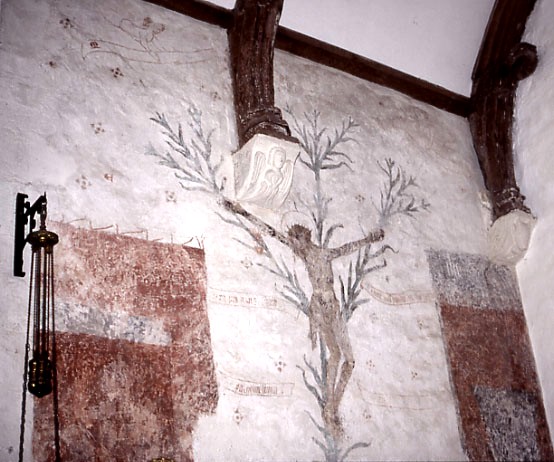Godshill, Isle of Wight (†Portsmouth) c.1450
Christ Crucified on a Lily
‘At once a Sonne is promis’d her, and gone,
Gabriell gives Christ to her, He her to John;
Not fully a mother, Shee’s in Orbitie,
At once receiver and the legacie.
All this, and all betweene, this day hath showne,
Th’Abridgement of Christs story, which makes one
(As in plaine Maps, the furthest West is East)
Of the Angels’s Ave,’ and Consummatum est…’
[John Donne, Upon the Annuntiation and Passion Falling upon one day. 1608]

Godshill’s name, according to the legend attached to the foundation of the church sometime in the reign of King Edward the Confessor (1042-1066), comes from the story that the builders tried three times to build the new church on a specific site, only to find each time that the stones had been moved overnight to a different location. Since the new site was therefore clearly one chosen by God himself, the church was built there – on God’s hill. The Lily-Cross, unique in English wallpainting¹, is in the south transept, the gates of which may be locked (this photograph was taken through its bars).
It shows Christ crucified on a lily, flanked by painted curtains with inscriptions on scrolls. The curtains once had painted or carved figures, perhaps of Mary and John, on or in front of them, and the outline of these is still faintly visible. Above, two hovering angels hold more scrolls, that on the left showing reasonably well. As is tantalisingly common, the various inscriptions are just below the threshold of decipherability.
It is likely that the lily-cross refers to the calendrical coincidence whose paradoxes Donne explores with obvious delight – several times in any given century, Good Friday falls on March 25, the Feast of the Annunciation. In the Middle Ages, various beliefs seem to have clustered around ‘this doubtful day of Feast or Fast’ [Donne, ibid. ll.5-6] and one of them, perhaps unsurprisingly, was that it heralded the Last Day and imminent Judgement. A variant belief, specifically English, was that it meant disaster for the realm, encapsulated in a rhyme – ‘When the Lord’s Day falls in Our Lady’s lap/England shall meet with a great mishap’².
The crucified Christ, long-limbed and thin to the point of emaciation, has a short loincloth and what looks like a spiky cap of thorns, rather than the more usual woven thorn-wreath. The branching lily has three stems, no doubt to symbolise the Trinity. The whole painting is of very high quality, particularly the lily itself in a delicate grey-green pigment, perhaps malachite.
Another Isle of Wight painting, the St Christopher at Shorwell, is also on the site.
¹ Although there are a few painted examples in Continental Europe and two small pieces of stained glass in England (St Michael’s, Oxford, and the Clopton Chantry in Long Melford church, Suffolk). There is also a modern window in the restored cell of the anchoress in the church of St Julian of Norwich, Norwich, Norfolk, England.
² Christina Hole quotes the rhyme (English Folklore, p.71), and Brewer has part of it in Phrase & Fable. Neither author speculates about dating or origin.